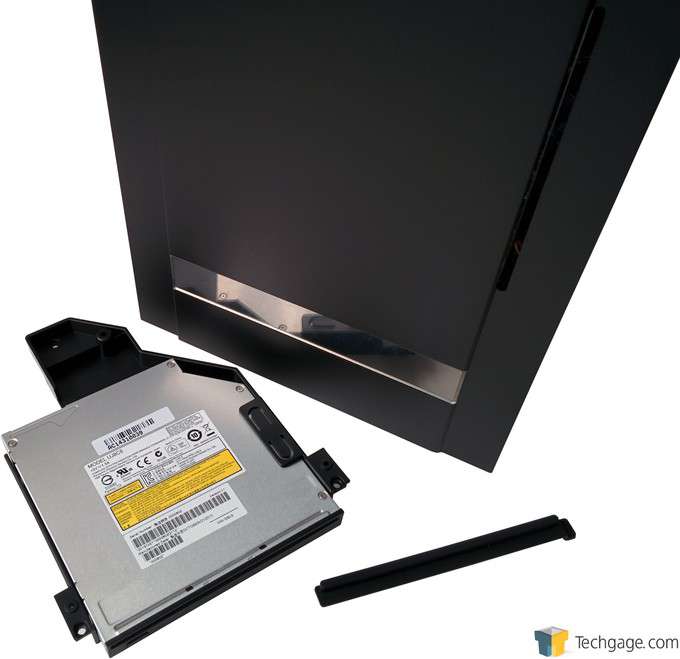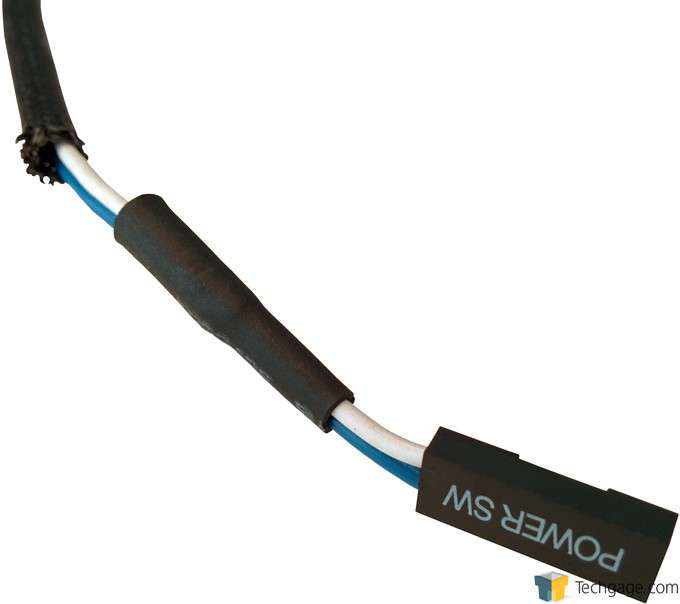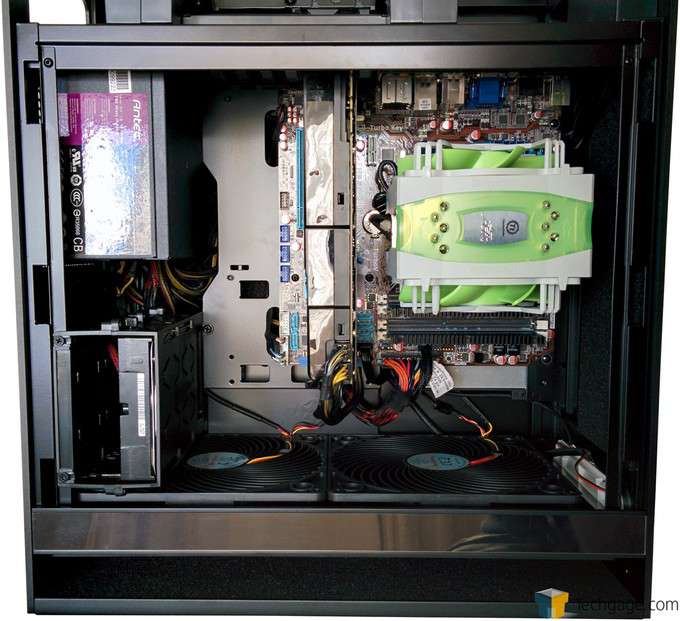- Qualcomm Launches Snapdragon 4 Gen 2 Mobile Platform
- AMD Launches Ryzen PRO 7000 Series Mobile & Desktop Platform
- Intel Launches Sleek Single-Slot Arc Pro A60 Workstation Graphics Card
- NVIDIA Announces Latest Ada Lovelace Additions: GeForce RTX 4060 Ti & RTX 4060
- Maxon Redshift With AMD Radeon GPU Rendering Support Now Available
SilverStone Fortress FT05 Mid-Tower Chassis Review

After having gone 3 years without looking at a SilverStone chassis, we’re back with a look at the company’s latest, the mid-tower Fortress FT05. Can it deliver on the promises of big cooling and big flexibility while retaining as small a footprint as possible? It’s time to man the fort and find out.
Page 2 – Installation & Testing
SilverStone also sent along an SOD02 slim optical drive so that we can test out every facet of the FT05. After removing the thin rubber strip that keeps dust from entering through the drive slot when not in use, it’s just a matter of removing three screws to free the plastic drive tray, securing the drive, then securing the assembled unit back in the system.
The only issue that we ran into during the build was when the heat shrink tubing pulling away from the wire leaving gaps between the connector and the sleeving. It could be that an insufficient amount of heat was applied to shrink the tubing enough to secure it in place, but whatever the reason it was the same story on multiple cables. This doesn’t affect the functionality of the chassis, but it means that the build doesn’t look as clean as it could due to the exposed wires.
I wouldn’t say that the FT05 is an advanced chassis, but building a system in it does require some extra time. While the installation was pretty straight forward despite the unique layout, the amount of space in the main compartment and behind the motherboard tray is likely less than what most are used to. Systems with more drives or multiple GPUs would mean even less room to work in as well as more cables that need to be tucked away. Our build took less than an hour with an extra 30 minutes after to properly route cables so the side panel could be secured, but with some extra planning, here’s the result.
All of our testing is performed in a near steady 20°C ambient environment with readings taken before and after with a standard room thermometer. AIDA64 Extreme Engineer is used for monitoring and recording all system temperatures throughout the testing process.
Windows is allowed to sit idle for 10 minutes after startup to ensure all services are loaded before recording the idle CPU and GPU temperatures. CPU load temperatures are generated by performing a 20 minute run of OCCT LINPACK using 90% of the available memory, while GPU load temperatures are generated by OCCT’s built in test, also for 20 minutes.
Stock CPU settings were obtained by setting the AI Tweaker option with the BIOS to Auto and the maximum stable overclock frequency of 4.0GHz was obtained after extensive testing to ensure stability. The final clocks for the GPU are 760MHz on the core and 1000MHz QDR (4000MHz relative) for the memory with the voltage increased to 1.087V using MSI’s Afterburner overclocking utility. As with the CPU overclock, testing was done prior to ensure full stability.
| Techgage Chassis Testing System | ||||
| Processor | Intel Core i5-661 – Dual-Core (3.33GHz) | |||
| Motherboard | ASUS P7H55D-M EVO mATX – H55-based | |||
| Memory | 1x4GB DDR3 1600MHz Kingston ValueRAM | |||
| Graphics | EVGA GeForce GTX 470 | |||
| Storage | Western Digital 2TB Green | |||
| Power Supply | Antec TP-750 Blue | |||
| Chassis | Corsair Carbide Air 240 | |||
| CPU Cooling | Noctua NH-C14 | |||
| Et cetera | Windows 7 Ultimate 64-bit | |||
| Idle | Load | |
| Processor | 28 | 43 |
| Graphics Card | 32 | 91 |
| Processor (OC) | 30 | 56 |
| Graphics Card (OC) | 34 | 92 |
All that I can say is “Wow!”
Well, that’s not all that I can say, but hopefully you understand why we’re left so impressed. Not only did the FT05 manage to keep the CPU temperatures below any other chassis since switching to the Thermaltake Jing as our test cooler, it also kept it neck-and-neck with the much larger and much more expensive Thermaltake Level 10GT that we tested with a Corsair H60 all-in-one liquid cooler. In our testing these liquid coolers have been superior to air coolers, but after seeing these results it’s safe to say that air cooling is still a viable option with the right chassis.
The FT05 also kept our extremely picky GTX470 locked at 92 degrees, which is normal, but it did so with the fan spinning at only 82%. Normally the fan spins up above 90%, and while this might not seem like much of an improvement, the additional noise generated is nothing short of ridiculous.
The FT05 itself isn’t what I would call quiet when the fans are spinning at 100%, but it’s not loud either. Having never seen the AP181 fans in action until now, I was hoping for a little less noise, but once they were toned down using the included fan controllers, they really began to shine. With the fans running at the lowest speed the system became nearly inaudible while still managing to keep the CPU at only 57 degrees and the GPU at 92 degrees with the fan spinning at 85% while overclocked under full load.
What started off as a bit of a shaky build has turned itself around with some incredible thermal performance. There’s a few points to ponder however as we wrap things up.
Support our efforts! With ad revenue at an all-time low for written websites, we're relying more than ever on reader support to help us continue putting so much effort into this type of content. You can support us by becoming a Patron, or by using our Amazon shopping affiliate links listed through our articles. Thanks for your support!







